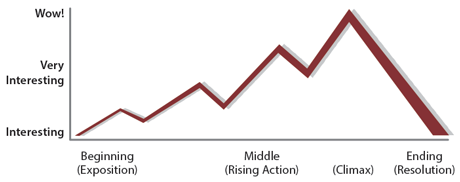Web Page: Plot Structure
Web Page: Classical Narrative Structure
The best stories display a common structure characterized by rising action that builds interest to a peak before falling again toward a satisfying resolution. This structure mirrors the shape of the most rewarding experiences in life, so it is not surprising that stories follow this structure.
The graph below plots narrative structure, using the x-axis to represent the story’s beginning, middle, and ending and the y-axis to represent the audience’s interest level. Employ narrative structure to develop a compelling story.

Note: Use narrative structure whenever you want to tell a story: narratives (real or imagined), plays, movies, podcasts, digital stories, and the like.
Your Turn Think about the plot of one of your favorite books, television shows, or movies. Outline the key points in the beginning, middle, and ending of the story and see how the structure compares to the one shown above. What are the benefits of the narrative structure? What would happen if a plot exhibited falling action, but no rising action? How would this change the audience’s experience?
Web Page: Plot Structure
Web Page: Classical Narrative Structure
© 2014 Thoughtful Learning
